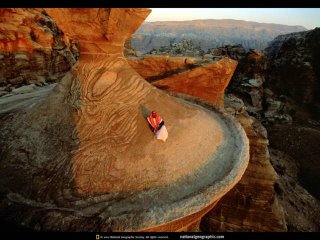

An ancient ruined city of Edom in present-day southwest Jordan. It flourished as a trade center and the capital of Nabataea from the 4th century B.C. until its capture by the Romans in A.D. 106. The city was taken by Muslims in the 7th century and by Crusaders in the 12th century. The ruins of the “rose-red city” were discovered in 1812.
Petra (pē'trə) , ancient rock city, in present-day Jordan, known to the Arabs as Wadi Musa for the stream that flows through it. A narrow, winding pass between towering walls leads to the open plain upon which stood the ancient city. The plain is surrounded by hills in which tombs have been carved in the pink sandstone. The site includes some 800 structures, the best known of which is the Khazneh el-Farun (or so-called Pharoah's Treasury), a mausoleum, monument, or temple with a two-story facade and Hellenistic split pediment.
Petra was early occupied by the Edomites and by the Nabataeans (an Arab tribe), who had their capital there from the 4th cent. B.C. until the Roman occupation in A.D. 106. The city is referred to as Sela in the Bible (2 Kings 14.7). It was for many centuries the focal point of a vast caravan trade but declined with the rise of Palmyra; however, it remained a religious center of Arabia. Under the Romans in the 2d and 3d cent. it was included in the province of Arabia Petraea. An early seat of Christianity, it was conquered by the Muslims in the 7th cent. and in the 12th cent. was captured by the Crusaders, who built a citadel there. Petra was unknown to the Western world until its ruins were visited by Johann Burckhardt in 1812.




Няма коментари:
Публикуване на коментар